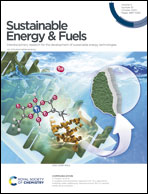Bipyrimidine core structure-based hole transport materials for efficient perovskite solar cells†
Abstract
In this work, a unique 2,2′-diphenyl-5,5′-bipyrimidine building block is used to synthesize two new hole transport materials (HTMs), named MD–T and MD–C, which are applied in conventional perovskite solar cells (PSCs). Carbazole derivatives and dimethoxydiphenylamine moieties are included in MD–C and MD–T as periphery groups, respectively. The introduction of the electron-withdrawing bipyrimidine group increases the molecular dipole moment, thus leading to an enhanced dipole–dipole interaction, which promotes charge transfer and affords a high hole mobility. Notably, MD–C with carbazole periphery groups exhibits well-matched energy levels with perovskite materials and shows a higher hole mobility along with a better film morphology. Eventually, the devices containing the MD–C HTM achieve a superior power conversion efficiency (PCE) of 19.93% with a high fill factor (FF) of 80.02%, surpassing that of MD–T based devices (PCE = 15.55%). Thereby, the newly designed MD–C with the 2,2′-diphenyl-5,5′-bipyrimidine core structure could be a promising candidate for constructing HTMs in PSCs.



 Please wait while we load your content...
Please wait while we load your content...